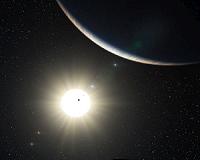| . |  |
. |
Moffett Field CA (SPX) Sep 02, 2010 Astronomers at the University of Hawaii have measured the temperature of a young gas-giant planet around another star using the W. M. Keck Observatory, and the results are puzzling. They have found that its atmosphere is unlike that of any previously studied extrasolar planet. By obtaining a spectrum of its emitted light, the astronomers determined the temperature of the planet. As a result, they found that current theoretical models of gas-giant planets did a poor job of explaining all the data. The team suspects that the reason is dust in the planet's atmosphere. Models with normal amounts of dust do not resemble this planet, but models with exceptionally thick dust clouds do a much better job. It therefore appears that young gas-giant planets are extremely cloudy. "We are at a point where not only can we directly image planets around other stars, but we can begin to study the properties of their atmospheres in detail. Direct spectroscopy of exoplanets is the future of this field," said Mr. Brendan Bowler, a graduate student at the University of Hawaii and the lead author of the study. The planet, known as HR 8799 b, is one of three gas-giant planets orbiting the star HR 8799, located 130 light-years away from Earth in the constellation Pegasus. (For reference, the distance to the nearest nighttime star from Earth is about 4 light-years.) HR 8799 b is the lowest-mass planet around the star, about 7 times the mass of Jupiter. This multiplanet system was discovered by direct imaging in 2008, and now, only a year and a half later, astronomers have obtained a spectrum of one of its planets. The spectrum of a planet contains much more information than a single image: it can reveal the temperature, chemical composition, and cloud properties of the planet. The technique the team used to determine the planet's temperature relies on the chemistry of the planet's atmosphere. Specifically, the presence or absence of gaseous methane can be used as a thermometer. The team found that HR 8799 b shows little or no methane in its atmosphere. Based on their spectrum and previously obtained images of the planet, and by comparing the observations to theoretical models of low-temperature atmospheres, they estimate the coolest possible temperature for the planet is about 1,200 Kelvin (about 1,700 degrees Fahrenheit). The models, however, did a poor job of reproducing all the data. Current theoretical models predict HR 8799 b should be about 400 Kelvin cooler than they measured, based on the age of the planet and the amount of energy it is currently emitting. The team suspects the discrepancy arises because the planet is much more dusty and cloudy than expected by current models. "Direct studies of extrasolar planets are just in their infancy. But even at this early stage, we are learning they are a different beast than objects we have known about previously," said University of Hawaii astronomy professor Michael Liu, coauthor of the study. The planets around HR 8799 are incredibly faint, about 100,000 times dimmer than their parent star. To obtain the spectrum of HR 8799 b, the team relied on the adaptive optics system of the Keck II Telescope to make an ultra-sharp image of the star for many hours. Then they used the facility instrument called OSIRIS, a special kind of spectrograph, to precisely separate the spectrum of the planet from the light of its parent star. "Adaptive optics systems on Keck and other large ground-based telescopes make sharper images than even the Hubble Space Telescope. With adaptive optics, we are learning an incredible amount about objects that are smaller than the lowest-mass stars and larger than the most massive gas-giant planets in our solar system," said Mr. Trent Dupuy, a University of Hawaii graduate student and coauthor on the study. Dr. Michael Cushing of the Jet Propulsion Laboratory was also a member of the team announcing these results. Although over 500 planets have been discovered around other stars, only six planets have been directly imaged. Three of these are around HR 8799 and were discovered in 2008 by Christian Marois of Canada's National Research Council and collaborators. When it was announced, the discovery represented one of the first direct images of light emitted from extrasolar planets.
Share This Article With Planet Earth
Related Links Keck Observatory Lands Beyond Beyond - extra solar planets - news and science Life Beyond Earth
 Seven-Planet System Discovered
Seven-Planet System DiscoveredMoffett Field CA (SPX) Aug 27, 2010 Astronomers using ESO's HARPS instrument have discovered a planetary system containing at least five planets, orbiting the Sun-like star HD 10180. The researchers also have tantalizing evidence that two other planets may be present, one of which would have the lowest mass ever found. This would make the system similar to our solar system in terms of the number of planets (seven as compared ... read more |
|
| The content herein, unless otherwise known to be public domain, are Copyright 1995-2010 - SpaceDaily. AFP and UPI Wire Stories are copyright Agence France-Presse and United Press International. ESA Portal Reports are copyright European Space Agency. All NASA sourced material is public domain. Additional copyrights may apply in whole or part to other bona fide parties. Advertising does not imply endorsement,agreement or approval of any opinions, statements or information provided by SpaceDaily on any Web page published or hosted by SpaceDaily. Privacy Statement |